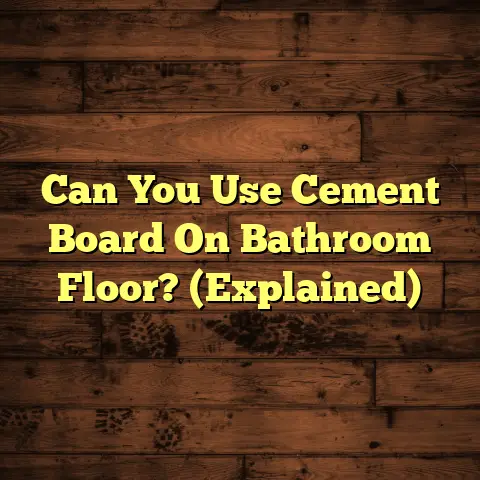How To Tile Bathroom Floor On Floorboards?
The bathroom. Often the smallest room, yet it bears the brunt of daily life. Think of your own. Is it a sanctuary? Or a space suffering from frayed edges, faded dreams, and a general aura of “blah”?
I’ve seen it all, folks. As a flooring contractor for over 20 years, I’ve witnessed bathroom transformations that would make HGTV blush. And today, I’m letting you in on a secret: you can tile that sad bathroom floor, even if it’s sitting on top of floorboards.
But hold on! This isn’t a walk in the park. Tiling over floorboards is like performing high-wire act – exhilarating, but one wrong step and… well, let’s just say you’ll be living with cracked tiles and a leaky mess for years.
So, grab a coffee (or something stronger), and let’s dive into this dramatic journey together.
Section 1: Understanding the Challenge – The Beast Within
Why is tiling over floorboards so…dramatic? Because you’re essentially asking two different materials to play nicely together. Floorboards, bless their wooden hearts, are prone to movement. They expand and contract with humidity changes. Tiles? They like to stay put.
Think of it like this: you’re trying to force a rigid, unyielding structure (the tiles) onto a constantly shifting foundation (the floorboards). It’s a recipe for disaster if you don’t understand the challenges.
Here’s what keeps me up at night when I hear “tiling over floorboards”:
-
Moisture Mayhem: Bathrooms are humid. Floorboards are porous. Water + Wood = Rot. It’s simple biology. If moisture penetrates through the grout and adhesive, you’re looking at warped boards, mold, and a potential structural nightmare.
-
The Unlevel Labyrinth: Floorboards rarely lie perfectly flat, especially in older homes. Dips, humps, and unevenness will telegraph right through your tiles. Imagine stepping onto your brand-new floor and feeling like you’re walking on a miniature mountain range.
-
Movement Madness: As I mentioned, floorboards move. This movement can cause tiles to crack, grout to crumble, and your beautiful new floor to look like a jigsaw puzzle gone wrong.
I once had a client who ignored these warnings. He thought he could slap some tiles down and call it a day. Six months later, I was back, ripping up his handiwork and installing a completely new subfloor. The moral of the story? Don’t underestimate the challenge.
According to the National Wood Flooring Association (NWFA), proper subfloor preparation is the most critical factor in a successful tile installation over wood. They estimate that over 80% of tile failures on wood subfloors are due to inadequate preparation. Ouch.
Section 2: Tools and Materials – The Arsenal of a Tiling Warrior
Alright, so you’re not scared off yet? Good! Let’s arm ourselves with the tools and materials we’ll need to conquer this tiling beast. Think of this as your arsenal – each item plays a vital role in the upcoming battle.
-
The Tiles (Our Shining Armor): Obvious, right? But don’t just grab any tiles. Consider the size, material, and thickness. Smaller tiles (like mosaics) are generally more forgiving on a slightly flexible subfloor. Porcelain is a great choice because it’s dense, water-resistant, and durable.
-
Adhesive (The Glue That Binds): This isn’t your everyday craft glue. You need a high-quality, flexible thin-set mortar specifically designed for use with wood subfloors. Look for terms like “polymer- modified” or “flexible” on the bag.
-
Grout (The Seam Sealer): Again, flexibility is key. Use a sanded grout that’s been modified with a latex additive for added strength and crack resistance. Epoxy grout is an even better (though more expensive) option, as it’s completely waterproof.
-
Underlayment (The Silent Guardian): This is your secret weapon. Underlayment acts as a buffer between the floorboards and the tiles, absorbing movement and preventing cracks. More on this later!
-
Sealer (The Protective Shield): After grouting, you’ll need to seal the grout lines to prevent water penetration. Choose a high-quality penetrating sealer designed for grout.
-
Tools of the Trade (The Instruments of Victory):
- Tile Cutter: For clean, precise cuts. A wet saw is ideal for porcelain tiles.
- Trowel: To apply the thin-set mortar evenly. Choose the correct notch size for your tiles.
- Spacers: To ensure consistent grout lines.
- Grout Float: To push the grout into the joints.
- Grout Sponge: To clean up excess grout.
- Level: Essential for ensuring a flat, even surface.
- Measuring Tape: For accurate measurements and layout planning.
- Pencil: For marking cuts and reference lines.
- Safety Glasses and Gloves: Protect yourself!
I know it seems like a lot, but trust me, having the right tools and materials will make the job much easier and increase your chances of success exponentially. Think of skipping any tool is like going into battle with a butter knife.
Section 3: Preparing the Floor – The Foundation of Success
This is where the magic happens. Or, more accurately, where the hard work happens. Proper floor preparation is absolutely critical for a successful tile installation over floorboards. Skimp on this step, and you’re practically guaranteeing a future disaster.
Here’s my step-by-step guide to prepping those floorboards:
-
Inspection (The Detective Work): Start by thoroughly inspecting the floorboards. Look for signs of damage, rot, or movement. Pay close attention to areas around the toilet and shower, where water damage is most likely to occur.
- The Bounce Test: Walk around the room and feel for any bouncy or spongy spots. This indicates that the floorboards are weak or damaged and need to be repaired or replaced.
- The Level Test: Use a long level to check for any dips or humps in the floor. Significant unevenness will need to be addressed before tiling.
-
Repair or Replace (The Surgeon’s Touch): Any damaged or weak floorboards must be repaired or replaced. This might involve patching small areas with wood filler or replacing entire boards.
- Pro Tip: When replacing floorboards, use screws instead of nails. Screws provide a much stronger and more secure hold.
-
Cleaning (The Scrub-Down): Give the floorboards a thorough cleaning to remove any dirt, dust, or debris. Use a strong degreaser to remove any grease or oil.
- The Vacuum Secret: After washing, vacuum the floor thoroughly to remove any remaining loose particles.
-
Fastening (The Reinforcement): This is where you ensure the floorboards are securely fastened to the joists. Drive screws through the floorboards and into the joists at regular intervals. This will help to minimize movement and create a more stable base for the tiles.
- Screw Placement is Key: Space screws every 6-8 inches along the joists.
-
Leveling (The Great Equalizer): If the floor is significantly uneven, you’ll need to level it out before tiling. This can be done using self-leveling compound or by installing a layer of plywood.
- Self-Leveling Magic: Follow the manufacturer’s instructions carefully when using self-leveling compound. It’s a fantastic product, but it needs to be applied correctly.
- Plywood Power: If using plywood, make sure it’s exterior-grade and at least 1/2 inch thick. Screw it down securely to the floorboards.
I can’t stress enough how important this preparation stage is. I’ve seen countless tiling jobs fail simply because the floorboards weren’t properly prepared. Don’t let that be you!
Section 4: Installing the Underlayment – The Unsung Hero
Okay, the floorboards are prepped, cleaned, and leveled. Now it’s time for the unsung hero of this whole operation: the underlayment.
Underlayment is a layer of material that’s installed between the floorboards and the tiles. It acts as a buffer, absorbing movement, reducing stress on the tiles, and preventing cracks. Think of it as a shock absorber for your floor.
There are several types of underlayment available, each with its own pros and cons:
-
Cement Board (The Stalwart Defender): This is a popular choice for tiling over wood subfloors. It’s made of cement and reinforced with fiberglass mesh, making it strong, durable, and water-resistant.
- Pros: Excellent stability, water resistance, and long lifespan.
- Cons: Can be heavy and difficult to cut.
-
Uncoupling Membrane (The Flexible Friend): These membranes are designed to “uncouple” the tiles from the subfloor, allowing them to move independently. This is a great option for floors that are prone to movement or cracking. Schluter Ditra is a popular brand.
- Pros: Excellent crack resistance, easy to install, and lightweight.
- Cons: Can be more expensive than cement board.
-
Plywood (The Budget Buddy): While not ideal, exterior-grade plywood can be used as an underlayment in some cases. However, it’s not as stable or water-resistant as cement board or uncoupling membrane.
- Pros: Relatively inexpensive and easy to work with.
- Cons: Less stable and water-resistant than other options.
For tiling over floorboards, I almost always recommend using cement board or an uncoupling membrane. The added stability and crack resistance are well worth the investment.
Here’s how to install cement board underlayment:
-
Measure and Cut (The Precise Execution): Measure the area to be covered and cut the cement board to size using a utility knife or a cement board saw.
-
Apply Thin-Set (The Sticky Situation): Apply a layer of thin-set mortar to the floorboards using a notched trowel.
-
Set the Boards (The Careful Placement): Carefully set the cement board sheets into the thin-set, making sure they are flat and level.
-
Screw Down (The Secure Fastening): Screw the cement board to the floorboards using cement board screws. Space the screws every 6-8 inches.
-
Tape the Seams (The Seal of Protection): Tape the seams between the cement board sheets using fiberglass mesh tape and thin- set mortar. This will create a seamless, water-resistant surface.
Once the underlayment is installed, you’re ready to start laying the tiles. You are now ready to build the walls of your fortress.
Section 5: Laying the Tiles – The Art of Transformation
This is it! The moment you’ve been waiting for. It’s time to transform that drab bathroom floor into a stunning tiled masterpiece. But before you start slapping down tiles willy-nilly, let’s talk about planning and technique.
-
Layout Planning (The Strategic Blueprint): Before you even open a bag of thin-set, take some time to plan your tile layout. Consider the size and shape of the room, the location of fixtures, and any design elements you want to incorporate.
- The Centerpiece Strategy: Start by finding the center of the room. Then, lay out a row of tiles along the centerline to see how they will align with the walls.
- The Symmetry Secret: Aim for symmetry whenever possible. This will create a more visually appealing and balanced look.
- The Cut Tile Consideration: Try to avoid having small slivers of tile along the edges of the room. Adjust your layout as needed to ensure that cut tiles are at least half the size of a full tile.
-
Applying Thin-Set (The Mortar Mastery): Now it’s time to mix and apply the thin-set mortar. Follow the manufacturer’s instructions carefully, and use the correct notch trowel for your tiles.
- The Consistency Conundrum: The thin- set should have the consistency of peanut butter. Not too runny, not too stiff.
- The Troweling Technique: Apply the thin-set in a consistent, even layer, using the notched trowel to create ridges. These ridges will help the tiles adhere securely to the underlayment.
- The Open Time Alert: Thin-set has an “open time,” which is the amount of time you have to set the tiles before the mortar starts to dry. Work in small sections to avoid the thin-set drying out before you can set the tiles.
-
Setting the Tiles (The Precise Placement): Carefully set the tiles into the thin-set, using spacers to maintain consistent grout lines. Press down firmly on each tile to ensure good contact with the mortar.
- The Level Check: Use a level to check that the tiles are flat and even. Make any necessary adjustments before the thin- set starts to dry.
- The Tap Technique: If a tile is slightly uneven, you can gently tap it into place using a rubber mallet.
- The Clean-Up Crew: Wipe away any excess thin-set from the tile surfaces as you go. This will make grouting much easier later on.
-
Cutting Tiles (The Shaping Skill): You’ll inevitably need to cut tiles to fit around fixtures and along the edges of the room. Use a tile cutter or a wet saw for clean, precise cuts.
- The Measurement Mastery: Measure carefully before cutting any tiles. It’s always better to cut a tile too large than too small.
- The Safety First: Wear safety glasses when cutting tiles to protect your eyes from flying debris.
- The Wet Saw Wisdom: If using a wet saw, make sure to keep the blade cool and lubricated with water.
-
Patience is a Virtue (The Zen Moment): Laying tiles takes time and patience. Don’t rush the process. Take your time, pay attention to detail, and enjoy the satisfaction of watching your new floor take shape.
I remember one time, I was tiling a particularly complex bathroom floor with intricate mosaic patterns. It took me days to complete, but the end result was absolutely stunning. The client was so thrilled that she burst into tears when she saw it. That’s the power of a well-tiled floor!
Section 6: Grouting and Finishing Touches – The Final Flourish
The tiles are laid, the thin-set is dry, and you’re almost there! Now it’s time for the final flourish: grouting and finishing touches. This is where you’ll transform your tiled floor from a collection of individual tiles into a cohesive, beautiful surface.
-
Grouting (The Sealing Ceremony): Mix the grout according to the manufacturer’s instructions, and apply it to the tile surface using a grout float. Work the grout into the joints, making sure to fill them completely.
- The Grout Consistency: The grout should have a smooth, creamy consistency.
- The Diagonal Stroke: Use the grout float to apply the grout in a diagonal motion, pressing firmly to fill the joints.
- The Excess Removal: Remove any excess grout from the tile surfaces as you go, using the grout float at a 45-degree angle.
-
Cleaning (The Scrubbing Ritual): After the grout has had a chance to set (usually about 15-30 minutes), use a damp sponge to clean the tile surfaces. Rinse the sponge frequently in clean water.
- The Gentle Touch: Be careful not to remove too much grout from the joints when cleaning.
- The Haze Removal: After the initial cleaning, you may notice a haze on the tile surfaces. This is normal and can be removed with a grout haze remover.
-
Sealing (The Protective Coating): Once the grout is completely dry (usually after 24-48 hours), apply a grout sealer to protect it from water and stains.
- The Penetrating Seal: Use a penetrating grout sealer that will soak into the grout and create a waterproof barrier.
- The Even Application: Apply the sealer evenly, using a brush or a sponge.
- The Wipe-Off Wisdom: Wipe off any excess sealer from the tile surfaces immediately.
-
Finishing Touches (The Polishing Perfection): Inspect the floor for any imperfections, and make any necessary touch-ups. Install baseboards or trim to cover the edges of the tile.
- The Caulk Consideration: Apply caulk along the perimeter of the room, where the tile meets the walls. This will create a watertight seal and prevent water from seeping behind the tiles.
- The Final Polish: Give the floor a final polish with a soft cloth to remove any remaining haze or streaks.
And there you have it! Your bathroom floor is now a stunning, durable, and waterproof masterpiece.
Conclusion – The Triumphant Finale
You’ve done it! You’ve successfully tiled a bathroom floor over floorboards. It was a challenging journey, but you persevered, and now you have a beautiful new floor to show for it.
Remember, tiling over floorboards requires careful planning, meticulous preparation, and a healthy dose of patience. But with the right tools, materials, and techniques, you can achieve professional-looking results.
So, go forth and conquer those sad, outdated bathroom floors! Transform them into stunning spaces that you’ll be proud to show off. And remember, if you ever get stuck, don’t hesitate to call a professional. We’re always here to help.
Now, stand back and admire your handiwork. You’ve earned it! Let the transformation begin!





